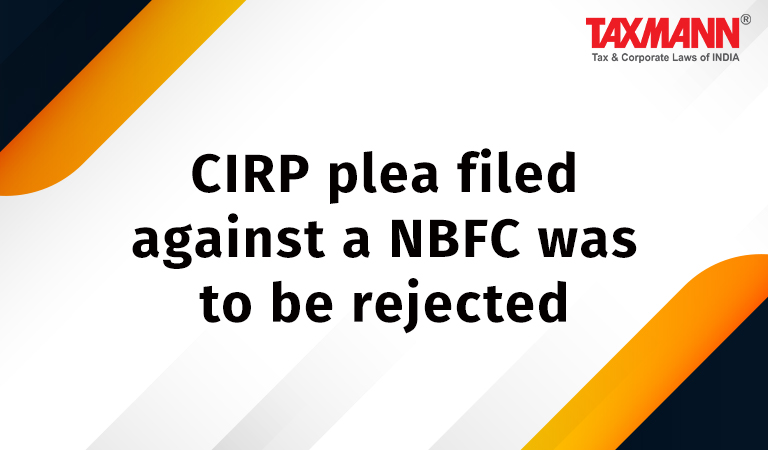CIRP plea filed against a NBFC was to be rejected
- Blog|News|Insolvency and Bankruptcy Code|
- 2 Min Read
- By Taxmann
- |
- Last Updated on 14 June, 2022

Case Details: Bank of India v. AKJ Fincap Ltd - [2022] 139 taxmann.com 34 (NCLT-Guwahati)
Judiciary and Counsel Details
-
- H.V. Subba Rao, Judicial Member & Prasanta Kumar Mohanty, Technical Member
- Bikash Sharma, Adv. for the Respondent.
Facts of the Case
In the instant case, AEPL approached the financial creditor and the financial creditor agreed to sanction an aggregate loan amount of Rs. 10.65 crores. The corporate guarantor AKJ offered its corporate guarantee and signed and executed the Deed of Guarantee.
AEPL failed to maintain the term loan account maintained by the financial creditor as it failed to pay installments as per terms and conditions. The term loan account was classified as NPA. The financial creditor issued a reminder letter to AEPL, to pay the interest and loan installments. Moreover, AEPL while admitting its liability submitted a One Time Settlement proposal, but the same could not be accepted by the financial creditor.
An application was filed under section 7 by the financial creditor and an ex parte order was passed by the Adjudicating Authority observing that notice was served on the corporate debtor, but there was no appearance. Aggrieved by said order an application was filed by corporate guarantor seeking a direction to set aside the ex parte order, which was dismissed by the Adjudicating Authority on the ground that the Adjudicating Authority had no power to review or set aside its own company petition admission order as per settled proposition of law.
On appeal filed by the corporate guarantor, the ex parte order was set aside subject to costs of Rs. 25,000 on the corporate guarantor to be paid to the financial creditor and parties were directed to appear before the Adjudicating Authority. As per the order of NCLAT, the Corporate guarantor paid Rs. 25000.00 to the financial creditor and the petition filed by the financial creditor under section 7 was taken up by the instant Bench afresh.
NCLT Held
NCLT observed that the corporate debtor was a financial service provider company as per the above sections, rules, etc., and there was no merit in the arguments and submissions of the financial creditor that the application filed by it under section 7 was to be admitted and CIRP was to be initiated even though it had admitted that the total assets of the corporate guarantor are Rs. 15.63 crores only which was well below the stipulated limit amount of Rs. 500.00 crores. The financial creditor had not followed the guidelines and filed the instant application under section 7 in respect of a financial service provider without following the due process of law.
Hence, the instant application was to be rejected at no cost. Further, it was made clear that the instant application filed under section 7 was rejected but the order of rejection will not affect the right of the financial creditor to seek recourse, if otherwise eligible, before another forum(s) as the applicant may determine to proceed.
Disclaimer: The content/information published on the website is only for general information of the user and shall not be construed as legal advice. While the Taxmann has exercised reasonable efforts to ensure the veracity of information/content published, Taxmann shall be under no liability in any manner whatsoever for incorrect information, if any.

Taxmann Publications has a dedicated in-house Research & Editorial Team. This team consists of a team of Chartered Accountants, Company Secretaries, and Lawyers. This team works under the guidance and supervision of editor-in-chief Mr Rakesh Bhargava.
The Research and Editorial Team is responsible for developing reliable and accurate content for the readers. The team follows the six-sigma approach to achieve the benchmark of zero error in its publications and research platforms. The team ensures that the following publication guidelines are thoroughly followed while developing the content:
- The statutory material is obtained only from the authorized and reliable sources
- All the latest developments in the judicial and legislative fields are covered
- Prepare the analytical write-ups on current, controversial, and important issues to help the readers to understand the concept and its implications
- Every content published by Taxmann is complete, accurate and lucid
- All evidence-based statements are supported with proper reference to Section, Circular No., Notification No. or citations
- The golden rules of grammar, style and consistency are thoroughly followed
- Font and size that’s easy to read and remain consistent across all imprint and digital publications are applied





